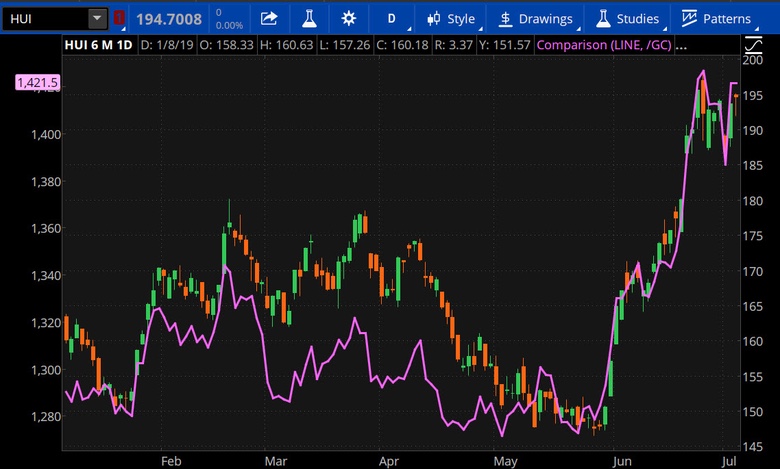Gold Futures Under Pressure After Stronger-Than-Forecast Jobs Number

You could think of today’s trading like a burger you might have had at a BBQ yesterday. It’s a meaty day of data sandwiched in between the Independence Day holiday and the weekend.
Though many investors are likely to use the Thursday holiday as a reason to take an extra-long weekend, there is one key bit of news to chew on today: the government’s monthly nonfarm payrolls report.
The headline number came in at 224,000, well above theBriefing.com consensus expectation for 160,000 jobs to be created. The new number is a hefty boost from the downwardly revised 72,000 jobs added the previous month.
Even though the futures market was still showing a certainty of a rate cut, stock market futures extended the morning’s losses as investors appeared to walk back some expectations of a dovish rate move by central bankers.
If that move continues into the trading day, it would be a case of strong economic data actually sending stocks lower, reversing a trend we saw in the last trading session.
Wednesday Roundup: Rate Cut Expectations Boost Stocks
On Wednesday, June payrolls data from ADP and Moody’s Analytics showed that private companies added 102,000 jobs. That was considerably lower than the 145,000 expected in a Briefing.com consensus.
So, with that sobering data ahead of today’s important government jobs report, why did each of three U.S. stock indices—the S&P 500 (SPX), Dow Jones Industrial Average (DJI) and Nasdaq (COMP)—finish Wednesday in the green? Three words: Interest rate expectations.
The weak ADP/Moody’s data appeared to feed into expectations that the Federal Reserve could cut interest rates later this month. The data also came during a week where factory orders were weaker than expected.
The rate-cut expectations seem to have boosted stocks on hopes of lowered borrowing costs for corporations as well as consumers who might want to buy homes or automobiles.
Still, this situation is a double-edged sword because while a slowdown in economic growth could lead to a Fed rate cut, it isn’t a great scenario for corporate profits and job security that can help bolster consumer confidence.
Perhaps that dichotomy is also behind why Consumer Staples and Real Estate outperformed the other S&P 500 Index (SPX) sectors on Wednesday. These sectors are often considered defensive and can move in the opposite direction to the wider market. But on Wednesday they moved in the same direction, just more so.
The Real Estate sector is also sensitive to moves in the bond market. So the sector probably got some additional help Wednesday as the benchmark 10-year Treasury fell to its lowest point since November 2016. Lower bond yields can make dividend-yielding bond proxies like Real Estate more attractive. Plus, lower yields at the back end of the curve can lower mortgage rates, and thus increase the buying power of home buyers.
But again, when the employment data came out this morning, the market looked to be reversing that trend to some degree.
What’s Up With Bonds?
But some investors may be wondering whether bond yields tend to move inversely with stock prices. Often, that can be the case, but this time around, it seems to be a sign that slowing economic growth could send investors into the relative safety of bonds even as they buy stocks in hopes of a rate cut. Overseas demand could also be helping U.S. government debt.
One thing that could help the market sort out how much it should be excited about a possibly more dovish Fed or pessimistic about the economy could be the upcoming earnings season. Once that gets underway in earnest, consider listening to comments from company executives about where they think the economy is headed, and how that might relate to their businesses in the near future. Such statements could either confirm the weakening data picture or provide an encouraging counterbalance to it.
Trading volumes were light Wednesday and it’s possible that they may be light today as well given that some investors may be taking a day of vacation to bridge the gap between the holiday and the weekend. It may be worth keeping in mind that light volume can exacerbate stock market volatility.

Figure 1: Gold futures (/GC) and the NYSE Arca Gold BUGS Index (HUI) have been on a tear recently amid worries about global growth and trade tensions as well as expectations for a Fed rate cut.However, today's strong employment reports sent gold down in early trading. Data source: NYSE, CME Group. Chart source: Thethinkorswim® platform from TD Ameritrade. For illustrative purposes only. Past performance does not guarantee future results.
Gold Miners Shining: Although gold futures were under pressure after this morning’s jobs report, recently, they hit their highest point since 2013 and the NYSE Arca Gold BUGS Index (HUI) of miners jumped to its highest point in more than a year. Gold is often viewed as a safe haven, so it has been getting some support from ongoing trade tensions and worries about global economic growth. But the precious metal is also viewed as an inflation and dollar hedge. The dollar had been under pressure as expectations of a Fed rate cut grew—lower rates can work to increase inflation and undermine the greenback. A weaker buck makes dollar-denominated gold less expensive for those holding other currencies, which can boost demand. That said, like stocks, bonds and gold, the dollar reversed course this morning after the release of the jobs report, with the U.S. Dollar Index (DXY) rising above 97 for the first time since June 20.
The recent rally in gold futures and gold miners may bring up questions about the different ways of investing in the yellow metal. On the one hand, owning gold futures gives investors relatively pure exposure to the price of gold. But gold futures, along with other commodities, are notoriously volatile and they don’t pay dividends. And futures involve leverage, which can exacerbate losses as well as gains. On the other hand, there are gold companies that do pay dividends, allowing investors to have exposure to the price of gold while at the same time having the potential to earn something extra. A downside there is that the exposure to gold isn’t as pure as with futures because gold miners carry risks such as a mine not being as profitable as expected or other company-specific risks that gold futures don’t have. And of course, dividends are never a guarantee.
Know Your Customer: Famed auto executive Lee Iacocca’s death brings memories of a man who had a real feel for consumer sentiment, something many companies today still struggle to understand. Back in 1964, Ford Motor Company F launched Iacocca’s most famous product, the Mustang, after Iacocca decided that young-adult baby boomers would go for a sporty, practical, cheap coupe. The car blew through annual sales expectations of 100,000 in just three months, with more than a million sold in the first year-and-a-half of production. Iacocca took some heat a decade later for redesigning the Mustang as a smaller, more fuel-efficient and much less powerful car in 1974, but the Mustang II—now widely derided by auto enthusiasts—was also a model that met consumer needs at the time, coming on the market just as a global fuel crunch caused gas prices to double.
Iacocca is also known for his contentious relationship with Ford CEO Henry Ford II, who according to biographies resented the accolades Iacocca received and ultimately fired Iacocca in 1978, saying afterward, “Sometimes you just don’t like somebody,” according to Iacocca. That might have stung, but Iacocca bounced back to help Fiat Chrysler Automobiles FCAU emerge from hard times in the early 1980s and introduce the minivan. Another case of knowing what the consumer wanted perhaps before consumers even knew it.
Information from TDA is not intended to be investment advice or construed as a recommendation or endorsement of any particular investment or investment strategy, and is for illustrative purposes only. Be sure to understand all risks involved with each strategy, including commission costs, before attempting to place any trade.
Image sourced from Pixabay
Disclosure: At the time of this writing, the author had no position in the mentioned equities.



